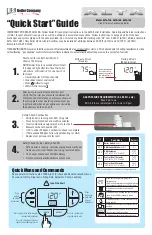
5
APPENDIX G – CHECkING DRAFT AND COMBUSTION
CHECK DRAFT (GAS BOILERS WITH DRAFT HOODS)
1.
Insofar as is practical, close all doors and
windows in the building.
2.
Turn on all appliances not connected to the
same venting system as the boiler being
checked.
3.
Turn on all exhaust fans (such as range
hoods and bathroom exhausts) to their
maximum speed. Do not turn on any
summer exhaust fans.
4.
Close all fireplace dampers.
5.
Operate the appliance being checked.
Follow lighting instructions.
CHECK DRAFT (OIL BOILERS)
1.
Use a manometer precise to 0.01” water
column.
2.
Fire the boiler until the chimney/vent reaches
normal operating temperature.
3.
Locate the pressure sensing tapping on the
boiler.
4.
While the boiler is still firing, use the
manometer to measure the draft at the
pressure tapping.
5.
Confirm that the draft measurement matches
the required draft specified for the boiler.
6.
If the required draft is not present, make any
necessary adjustments and check again.
CHECK COMBUSTION
1.
Use a flue gas analyzer that accurately
measures CO
2
, O
2
, CO, and flue gas
temperature.
2.
For oil boilers, also use a smoke tester with
smoke test paper.
3.
Operate the boiler at its rated (high fire)
input.
4.
With the analyzer, check the CO
2
(or O
2
), CO
and temperature of the flue gases exiting the
boiler.
5.
For two-stage or modulating boilers, also
check the CO
2
(or O
2
), CO and temperature
of the flue gases at low fire.
6.
Confirm that the measured CO
2
(or O
2
)
matches the required CO
2
(or O
2
) specified
for the boiler.
7.
For oil boilers, also take a smoke
measurement of the flue gases. Smoke
should not exceed #1.
If CO
2
, O
2
, or CO fall outside of the
range specified for the boiler, review the
installation and startup instructions and make any
necessary adjustments to the boiler or associated
venting or piping systems.
i
Note the gross flue gas temperature for
future reference. Significant changes in
flue gas temperature can indicate changes
in the boiler’s operating efficiency.
6.
After 5 minutes of main burner operation,
test for spillage at the draft hood relief
opening, using a lighted match, candle,
cigarette, etc.
7.
Repeat this test for each appliance
connected to the common venting system.
8.
If any appliance does not vent properly, per
the above test, make corrections, so that the
installation conforms to the
National Fuel
Gas Code
,
NFPA 54/ANSI Z223.1
, and/or
Installation Codes
,
CAN/CSA B149.1.
9.
Return doors, windows, exhaust fans,
fireplace dampers, and any other gas-
burning appliance to their previous condition
of use.
Содержание ESC
Страница 6: ... Figure S 1 Minimum Clearances to Combustibles SPECIFICATIONS continued ...
Страница 30: ...30 Internal Wiring Figure IW 1 Wiring Diagram ...
Страница 31: ...31 Internal Wiring continued Figure IW 2 Wiring Diagram ...
Страница 37: ...37 APPENDIX B1 INTENTIONALLY OMITTED ...
Страница 50: ...50 Figure D 0 Piping Schematic Symbols APPENDIX D System Piping continued ...
Страница 62: ...62 SERVICE RECORD DATE SERVICE PERFORMED ...
Страница 63: ...63 SERVICE RECORD DATE SERVICE PERFORMED ...
Страница 64: ...64 U S Boiler Company Inc P O Box 3020 Lancaster PA 17604 717 397 4701 www usboiler burnham com ...








































